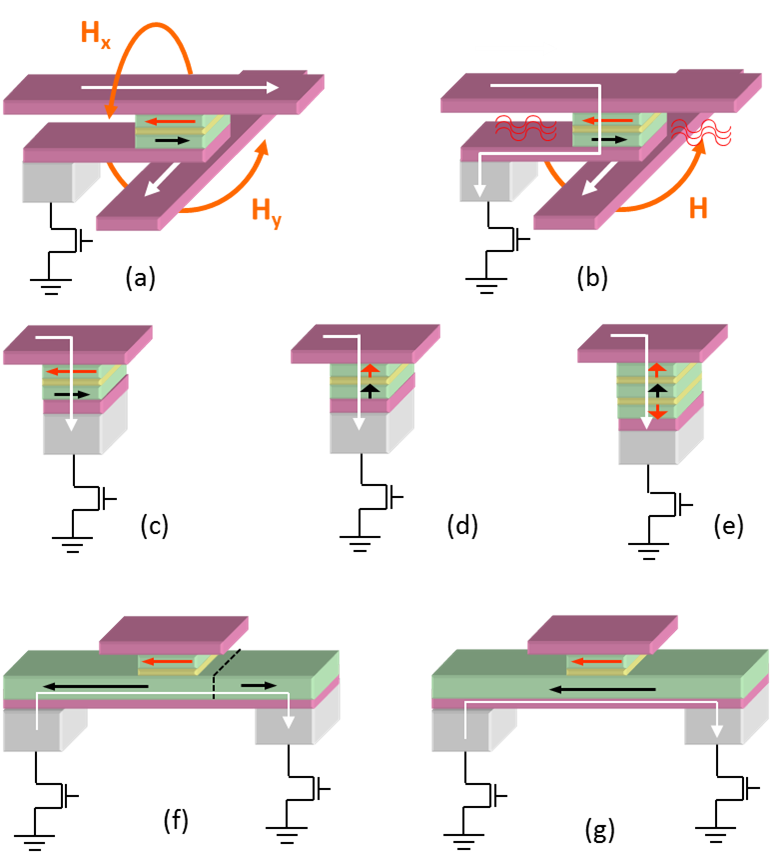Thematic overview
Magnetic Random Access Memories (MRAM) is a non-volatile memory technology, where information is stored by the magnetization direction of magnetic electrodes, very similar to computer hard-disk drives. The goal for MRAM memory is to simultaneously achieve high-speed read/write times, high density and unlimited cycling compared to other existing and emerging technologies.
Our group is developing advanced MRAM cell concepts patented at Spintec. The concepts are based on the use of temperature to reduce power consumption and increase the stability of the stored information. These ideas go beyond the conventional MRAM approach. The naturally occurring temperature increase during the write step is not lost, but is instead used to achieve the seemingly opposing goal of lowering the power consumption and increasing the thermal stability in the operating temperature range. Our group fosters young and experienced researchers developing/applying their expertise in the field of MRAM.

Questions to be addressed
Our main research axis is to use the naturally occurring temperature increase during the write step, when a current flows through the magnetic tunnel junction. The heating is used to go above a temperature threshold, making it possible to write the storage layer magnetization. This principle has been applied to in-plane magnetization cells using a storage layer pinned by an anti-ferromagnet and recently to perpendicular anisotropy cells. Our group’s goal is to demonstrate the proof-of-concept and then improve MRAM cell properties.
Our work involves the development of magnetic material systems, nano-fabrication (20-200nm cells), characterization of devices (magnetic & electrical) and simulation of the device behavior. Our activity in these vast fields is as follows;: On materials research, we are developing magnetic tunnel junctions with in-plane and perpendicular magnetic anisotropy. New electrode stacks having the material properties required by each specific concept need to be integrated in magnetic tunnel junctions, while achieving high levels of TMR signal. For the characterization of each concept we determine the write window parameters in terms of magnetic field, power consumption and magnetization reversal dynamics. Macrospin and micromagnetic simulation provide a better physical understanding of the system properties and the possibilities for optimization.
Projects
ANR EXCALYB – Perpendicular Anisotropy Materials for High-Density Non-volatile Magnetic Memory Cells
Crocus R&D – Thermally assisted MRAM
Samsung SGMI
Partners
Crocus Technology
Institut Néel
SP2M/NM
SAMSUNG
Applied Materials
SINGULUS
Recent news
- seminar – Measuring MRAM with Scanning NV Microscopy [March 03rd, 2023]
On Tuesday, March 07th 2023, we have the pleasure to welcome in SPINTEC Mathieu MUNSCH CEO and Co-founder of QNAMI. He will give us a seminar at 16:00, entitled: Measuring MRAM with Scanning NV Microscopy Place: SPINTEC ... - Seminar – Coupled magnetic and molecular dynamics: Methodology and application to the simulation of magneto-elastic effects in iron [March 01st, 2023]
On Thursday, March 16 2023, we have the pleasure to welcome in SPINTEC Julien Tranchida, Research Scientist at CEA Cadarache. He will give us a seminar at 14:00, entitled: Coupled magnetic and molecular dynamics: Methodology and ... - Waking-up wireless sensor nodes with perpendicular magnetic tunnel junctions [December 19th, 2022]
Spin-torque-nanodiodes based on magnetic tunnel junctions are promising candidates for RF energy harvesters and ultra-low power wake-up receivers with performances that are expected to surpass those of semiconductor diodes. Experiments on magnetic tunnel junctions with ... - Seminar – Characterization of the Switching Distributions of Heat-Assisted Magnetic-Recording Media [November 14th, 2022]
On Tuesday, November 22th, Pierre-Olivier Jubert Senior Technologist at Western Digital, San Jose (USA) will give us seminar on-line at 16:00, entitled : Characterization of the Switching Distributions of Heat-Assisted Magnetic-Recording Media Place : CEA Building 10.05 ... - Masters thesis projects for Spring 2023 [September 21st, 2022]
You find here the list of proposals for Master-2 internships to take place at Spintec during Spring 2023. In most cases, these internships are intended to be suitable for a longer-term PhD work. Interested Master-1 ...

SOUSA Ricardo
ricardo.sousa@cea.fr

BALTZ Vincent
vincent.baltz@cea.fr

PREJBEANU Lucian
lucian.prejbeanu@cea.fr

DIENY Bernard
bernard.dieny@cea.fr





